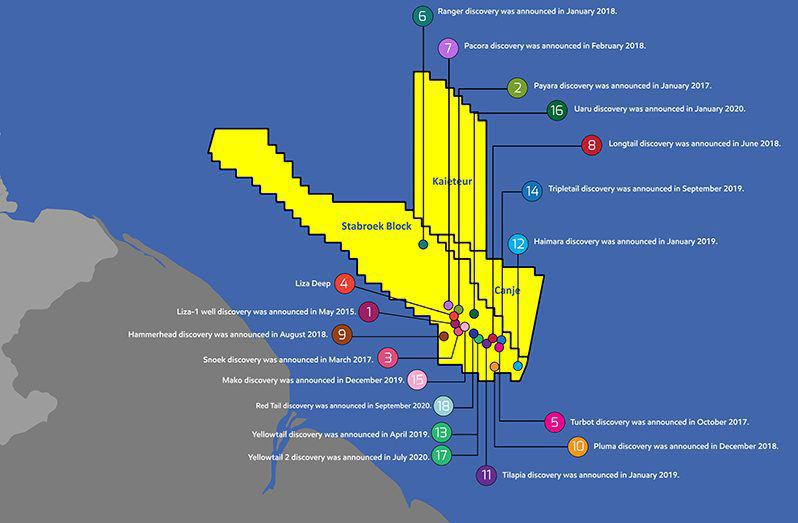–the results of consistent operations in Guyana’s petroleum sector
GUYANA’S petroleum sector has been the epitome of productivity in recent times, abuzz with activities that have proven fruitful for both the nation and its investors.
Though not without its challenges, the sector has, over the past few months, consistently produced positive results, stretching from significant contributions to economic growth and a new discovery of high-quality oil at the Stabroek Block offshore Guyana to increased revenues for the country.
According to the Bank of Guyana, the nation recorded positive growth at the end of the first quarter, primarily on account of oil production.
The Guyanese economy, unlike others which could not withstand the effects of COVID-19 and other external shocks, continued to benefit from oil production. Crude oil production increased to 11 million barrels at the end of March 2021, as daily oil production increased significantly when compared to one year earlier.
Moving forward, the local economy is expected to build on its performance in the first quarter, as it is projected to record real oil Gross Domestic Product (GDP) growth of 20.9 per cent, while the non-oil economy is estimated to grow by 6.1 per cent.

Based on those projections, there is no doubt that the contributions of the petroleum sector are already significant, with further growth on the horizon as time passes.
A signal of the impending growth in the sector was ExxonMobil’s 20th oil find offshore Guyana, in June, this year. The latest detection was made at the Longtail-3 site in the Stabroek Block.
A statement from ExxonMobil said that drilling at Longtail-3 encountered 230 feet (70 meters) of net pay, including newly identified, high quality hydrocarbon bearing reservoirs below the original Longtail-1 discovery intervals. It specified that the well is located approximately two miles (3.5 kilometers) south of the Longtail-1 well. It was drilled in more than 6,100 feet (1860 meters) of water by the Stena DrillMAX.
Outside of this find, over at the Canje Block, even as the prospects remain promising, the latest well drilled there by ExxonMobil, Jabillo-1, came up dry after being drilled down to 6,475 meters.
Westmount Energy, a holding company for a group of subsidiaries which operate in the oil-and-gas-related industries, reported that it has been informed by JHI Associates Inc. that the Jabillo-1 well on the Canje Block reached its target depth without encountering commercial hydrocarbons.
The Jabillo-1 well was drilled down to 6,475 meters in 2,903 meters of water by the Stena Carron drillship.
Considering the outcome of this operation, the well will be plugged and abandoned, as operator, ExxonMobil, turns its attention to the largest prospect to date at the Canje Block, the Sapote-1 well, located about 100 kilometers away from Jabillo-1.
According to Westmount Energy, Sapote-1 is located closer to Exxon’s upper cretaceous discoveries in the Stabroek Block. It is described as an independent multi-layer prospect, which will evaluate several upper cretaceous targets.
It is anticipated that Sapote-1 will be spudded in mid-August, using the Stena DrillMAX drillship, with results due to follow in October.
Further, drilling of the Kawa-1 well, the first well at the Corentyne Block offshore Guyana, is set to commence before August 15 and will cost close to US$85 million, CGX Energy Inc has said.
The Kawa-1 well is located in the north-east quadrant of the Corentyne Block, approximately 200 km offshore Georgetown. The water-depth is approximately 355 metres (1,174 ft) and the expected total depth of the Kawa-1 well is 6,575 metres (21,700 ft).
As previously announced by CGX, Kawa-1 will be drilled by the Maersk Discoverer, a sixth-generation, semi-submersible, currently working in Trinidad for another operator.
Based on the latest update from the company, the well is expected to be spudded within August 1 to August 15 and reach total depth in approximately 85 days. The primary target of the Kawa-1 well is a Santonian age, stratigraphic trap.
The estimated cost to drill and evaluate Kawa-1 is between approximately US$80-$85 million, which CGX expects to finance from one or more options that are currently being considered by the company.

It was reported, in February, that an independent prospective resource study has affirmed the world-class prospects of the Corentyne and Demerara blocks.
“As confirmed by the independent resource evaluation commission, the Guyana basin offers the joint venture access to a leading offshore oil opportunity. We expect a robust Guyana work programme with the advancement of our exploration wells, as we continue executing on our plan to realise this value for our shareholders.
“The independent prospective resource study reaffirms our excitement about the world-class prospectivity of the Corentyne and Demerara blocks offshore Guyana,” former Chief Executive Officer (CEO) of Frontera, Richard Herbert, said.
The independent prospective resource study and report captured the Corentyne North Area, Corentyne Main Area and Demerara Block, offshore Guyana.
Outside of the prospective projects, U.S oil giant ExxonMobil is the only operator, so far, which has started production offshore Guyana. This company –- operator of the Stabroek, Canje and Kaieteur blocks –- has made 20 discoveries since May 2015 and began production in December 2019 from the Liza Phase One development project.
ExxonMobil’s first offshore Guyana project at the Stabroek Block, Liza Phase One, began producing in late 2019, well ahead of the industry’s average for development time. Liza Phase Two remains on track to begin producing oil by early 2022.
Liza Phase Two will produce up to 220,000 barrels of oil per day at peak rates, using the Liza Unity FPSO. First Lady of Guyana, Mrs. Arya Ali, was officially designated as the Liza Unity’s “Godmother,” as it prepares to set sail from Singapore for Guyanese waters.
Late last year, the oil giant, following an agreement with the Government of Guyana, decided to proceed with the Payara field development offshore Guyana.
Payara is ExxonMobil’s third project in the Stabroek Block, and is expected to produce up to 220,000 barrels of oil per day, after start-up in 2024, using the FPSO vessel. The US$9 billion development will target an estimated resource base of about 600 million oil-equivalent barrels.
So far, Guyana has recorded US$344,161,633 in direct earnings from its petroleum sector. And, with oil prices on the rise globally, Guyana could see the returns from its burgeoning petroleum sector growing, starting with earnings from the sale of its seventh oil lift, which could rake in around US$75 million.
Revenue garnered from the sale of the seventh oil lift could push Guyana’s total earnings to close to US$420 million.



.jpg)








